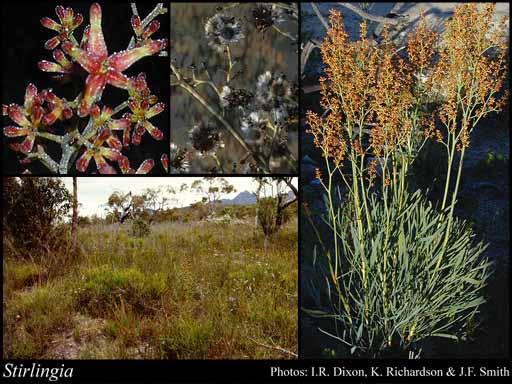- Reference
- Gen.Pl. p339 (1838)
- Name Status
- Current

Scientific Description
Common name. Blueboy. Family Proteaceae.
Habit and leaf form. Shrubs (or undershrubs), or herbs; evergreen. Perennial (with taproot or woody rootstock). Leaves mainly basal, or basal and cauline. To 0.1–1.5 m high. Mesophytic, or xerophytic. Leaves small to medium-sized; alternate (mostly on lower part of stem); spiral; leathery (or soft); petiolate; non-sheathing; simple; epulvinate. Leaf blades dissected; flat, or solid; terete; dichotomously dissected (or rarely 3-branched); one-veined, or pinnately veined, or palmately veined. Mature leaf blades adaxially glabrous; abaxially glabrous. Leaves without stipules. Leaf blade margins entire. Leaves without a persistent basal meristem. Leaf anatomy. Hairs absent. Stem anatomy. Secondary thickening developing from a conventional cambial ring.
Reproductive type, pollination. Fertile flowers hermaphrodite and functionally male. Unisexual flowers present. Plants andromonoecious. Entomophilous, or ornithophilous, or cheiropterophilous, or pollinated by unusual means.
Inflorescence and flower features. Flowers aggregated in ‘inflorescences’. Inflorescence many-flowered. Flowers in racemes, or in spikes, or in heads. Inflorescences simple, or compound (paniculately branched); scapiflorous, or not scapiflorous; terminal; pseudanthial, or not pseudanthial. The fruiting inflorescence not conelike. Flowers sessile; bracteate (bracts small); small to medium-sized; regular; 4 merous; cyclic; tetracyclic. Floral receptacle developing a gynophore, or with neither androphore nor gynophore. Free hypanthium absent. Hypogynous disk absent. Perianth of ‘tepals’; 4; 1 -whorled; free (straight, lobes of limb separating and reflexed at anthesis); yellow, or red, or pink, or purple, or violet, or blue, or brown. Androecial members definite in number. Androecium 4. Androecial members adnate; all equal; free of one another; 1 -whorled. Stamens 4; isomerous with the perianth. Anthers connivent (initially, in a ring around the style, the cells of 2 adjoining anthers united into a single cell), or separate from one another (becoming recurved with the sepals); basifixed; non-versatile; dehiscing via longitudinal slits; introrse; bilocular; tetrasporangiate. Fertile gynoecium present, or absent (in male flowers). Gynoecium 1 carpelled. The pistil 1 celled. Gynoecium monomerous; of one carpel; superior. Carpel stylate; apically stigmatic. Style straight (the style-end broadly cupular, pollen presenter absent). Carpel 1 ovuled. Placentation marginal, or apical. Ovary sessile. Ovules funicled, or sessile; non-arillate; orthotropous, or anatropous, or amphitropous, or hemianatropous.
Fruit and seed features. Fruit falling from the plant before the next growing season (when mature); non-fleshy; hairy (densely silky). The fruiting carpel indehiscent; nucular (nut obconical). Seeds non-endospermic. Embryo well differentiated. Cotyledons 2(–8). Embryo straight.
Geography, cytology, number of species. Native of Australia. Endemic to Australia. Australian states and territories: Western Australia. South-West Botanical Province. N=13.
Etymology. After Sir James Stirling (1791–1865), first governor of Western Australia 1829–38, who encouraged the study of native plants.